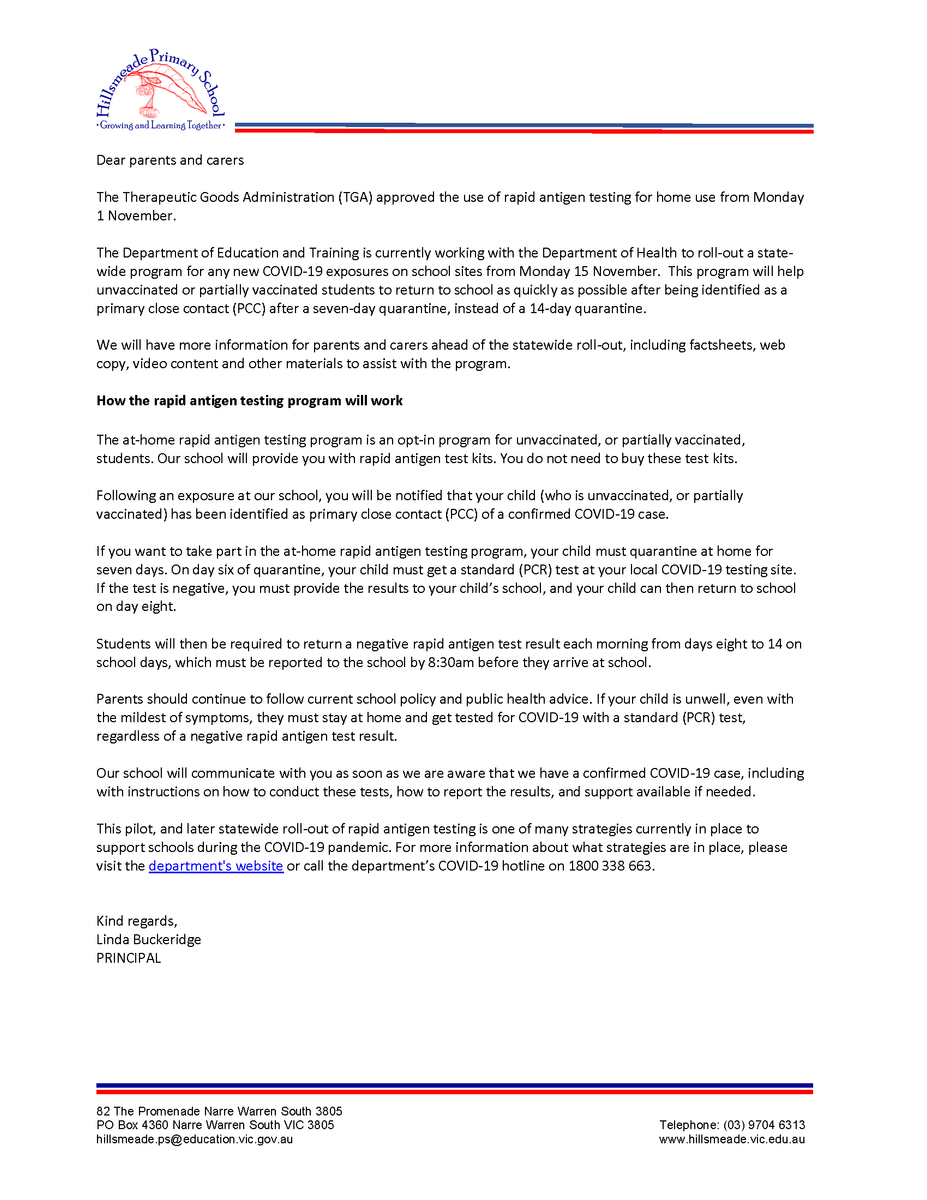Rapid antigen testing pilot FAQs

What is the at-home rapid antigen testing pilot?
The Department of Education and Training is working with the Department of Health to pilot an approach for up to 20 schools from Monday 8 November, using at-home rapid antigen testing of unvaccinated primary close contacts (PCCs) to reduce quarantine time and enable an earlier return to school. This trial will enable unvaccinated or partially vaccinated students to return to school after a seven-day quarantine, instead of a 14-day quarantine, by participating in this program.
Why are you starting the statewide roll-out with a pilot?
The Department of Education and Training is piloting the use of rapid antigen tests in a small number of schools in the week of Monday 8 November. The results of the pilot will inform the roll-out of the rapid antigen testing program across the state from Monday 15 November to help as many students return to onsite schooling as quickly and as safely as possible.
The information we collect during the pilot will be used to help us implement the rapid antigen testing in the most efficient way possible. During the pilot, we will learn how children and their families feel about using the rapid antigen testing in their homes, and the experience of schools to oversee the testing.
My school is participating in the pilot and my child is a primary close contact. What do I need to do?
The at-home rapid antigen testing program is an opt-in program for unvaccinated, or partially vaccinated students. Your school will provide you with rapid antigen test kits. You do not need to buy these test kits.
Following an exposure at school, you will be notified that your child (who is unvaccinated, or partially vaccinated) has been identified as a primary close contact (PCC) of a confirmed COVID-19 case. If your school is participating in the at-home rapid antigen testing program they will advise you of that.
If you want to take part in the at-home rapid antigen testing program, your child must quarantine at home for seven days. On day six of quarantine, your child must get a standard (PCR) test at your local COVID-19 testing site. If the test is negative, provide the results to your child’s school. Your child can return to school on day eight.
In order to return to school from day eight, your child must complete daily rapid antigen tests at home on each school day between days eight, nine, 10, 11, 12, 13 and 14 and return a negative test result each day. You must notify your school of your child’s test result each day via the web-based form. If your child’s test result is negative, your child can return to school for that day.
If your child returns a positive test, you must keep them home and take them for a standard (PCR) test at your local testing site. Your child cannot return to school until they return a negative standard (PCR) test.
If your child returns an invalid rapid antigen test, perform a second rapid antigen test. If the second rapid antigen test is invalid, you will need to keep your child home and take them for a standard (PCR) test. Your child cannot return to school unless they return a negative standard (PCR) test.
Your child then needs to have a standard (PCR) test on day 13. Provided it is negative, your child can then return to school on day 15 (and provide the result to school).
What do I need to do if I want my child to take part in this rapid antigen testing pilot?
Your school will notify you if your child is eligible to participate in the rapid antigen testing program. If you want to take part in the at-home program, your child must quarantine at home for seven days. On day six of quarantine, your child must get a standard (PCR) test at your local COVID-19 testing site. If the test is negative, provide the results to your child’s school.
Your school will provide information about rapid antigen testing and participation in the pilot, and will seek your consent to participate by undergoing daily rapid antigen testing on each school day for days eight, nine, 10, 11, 12, 13 and 14 to support early return to school.
You will need to provide your consent to the school, and you must report your child’s rapid antigen test result to their school, no matter what the result.
Report your child’s test results to your school using the e-form provided daily on days eight, nine, 10, 11, 12, 13 and 14 each school day morning to support continued early return to school.
You must send the test result to your school using the e-form provided prior to your child attending school and no later than 8.30am.
Your child then needs to have a standard (PCR) test on day 13. Provided it is negative, your child can then return to school on day 15 (and provide the result to school).
If my child has been vaccinated, do they need to participate in the rapid antigen testing program?
Vaccinated students must quarantine at home for seven days. On day six of quarantine, your child must get a standard (PCR) test at your local COVID-19 testing site. If the test is negative, you need to provide the results to your child’s school. Your child can return to school on day eight. Your child is not eligible to participate in the rapid antigen testing program.
Statewide
What will the statewide roll-out look like from 15 November?
More information will be provided about the roll-out of rapid antigen testing for unvaccinated PCCs in schools.
The findings from the pilot will inform the statewide roll-out of the rapid antigen testing program, to help as many students return to onsite schooling as quickly and as safely as possible.
Will non-government schools be included in the statewide roll-out?
Yes. We are working with the non-government school sector to support roll-out to all schools.
Testing
What is rapid antigen testing?
Rapid antigen tests can check if you may have COVID-19. These tests can be done at home by yourself. Most rapid antigen tests will provide you with a result in 15 to 30 minutes.
How is it different to standard PCR COVID-19 testing?
Rapid antigen tests are self-administered COVID-19 tests that can be used at home. They can tell you if you are likely or not likely to have COVID-19.
Rapid antigen tests are not as accurate as standard PCR tests, and some cases will be missed. The accuracy of the test depends on how well the sample was taken and what stage you are in an infection. Rapid antigen tests are also more effective in people with symptoms and in people in the middle phase of their infection. The Victorian Government recommends standard (PCR) testing to diagnose COVID-19. PCR testing is free and available to all Victorians at many locations.
Rapid antigen testing does not replace standard (PCR) testing for the purpose of diagnosis of COVID-19 in children, staff and students with symptoms, regardless of their vaccination status.
Parents should continue to follow current school policy and public health advice; if your child is unwell, even with the mildest of symptoms, they must stay at home and get tested for COVID-19 with a standard (PCR) test, regardless of a negative rapid antigen test result.
How do I conduct the test?
There are different types of rapid antigen tests, and your school will provide you with Roche variety. Follow the instructions in your kit, as they may differ from other types of tests. Read the full instructions included in your kit before starting the test.
Can my child self-administer the test?
Children who are 12 to 17 years old who want to do the test themselves should be supervised to ensure they correctly follow the steps. Children under 12 will need a parent or guardian to perform the test on them.
What does a positive result mean?
A positive result means it’s likely your child has COVID-19, especially if they have symptoms.
If your child gets a positive result, they must:
- isolate at home immediately
- get a standard (PCR) test to confirm the result as soon as possible at a testing site or through your healthcare provider
- stay isolated until they get their standard (PCR) test result.
After your child’s follow-up standard (PCR) test:
- if your child gets a positive result from the standard (PCR) test, then they have COVID-19. If your child has COVID-19, see what to do
- if your child gets a negative result from the standard (PCR) test, they can leave isolation and return to school. Your child must continue to have at-home rapid antigen tests every second day until 14 days after the original exposure date.
You must report your child’s rapid antigen test result and standard (PCR) test result to your school.
You can tell other household members or other people you may have seen outside the home about your child’s positive rapid antigen test result if you want to. But they don’t need to take any action until your child’s standard (PCR) test confirms they have COVID-19.
A positive rapid antigen test result means it is likely your child has COVID-19. They will need to isolate immediately, and also get an immediate standard (PCR) test. When you do this, be sure to tell the testing site about your child’s positive rapid antigen test.
When can my child return to school with a positive test result?
If your child gets a positive result, they must:
- isolate at home immediately
- get a standard (PCR) test to confirm the result as soon as possible at a testing site or through your healthcare provider
- stay isolated until they get their standard (PCR) test result.
After your child’s follow-up standard (PCR) test:
- if your child gets a positive result from the standard (PCR) test, then they have COVID-19. If your child has COVID-19, the Department of Health will provide you with further advice. Your child cannot return to school until the Department of Health has advised of release dates following an isolation period.
You must report your child’s rapid antigen test result and standard (PCR) test result to your school.
What does a negative result mean?
A negative result means it’s less likely your child has COVID-19. A standard (PCR) test can tell accurately whether your child has a confirmed diagnosis of COVID-19.
If your child has COVID-19 symptoms, they must get a standard (PCR) test.
If your child has been further exposed to COVID-19 (beyond the original school exposure), they must get a standard (PCR) test.
You must report your child’s negative rapid antigen test result to your school so your child can return to school.
It is unlikely your child has COVID-19, especially if they have no symptoms. If your child has symptoms, they must get a standard (PCR) test to be sure. If they don't have symptoms, they don't need to get a standard (PCR) test.
When can my child return to school with a negative test result?
If you opt-into the at-home Rapid Antigen Testing Program
- Your child must quarantine at home for seven days.
- On day six of quarantine, your child must get a standard (PCR) test at your local COVID-19 testing site. If the PCR test is negative, you must provide the results to school.
- Your child can return to school on day eight if you participate in the daily at home rapid antigen testing program.
- On day 13, your child must get a standard (PCR) test at your local COVID-19 testing site. If the PCR test is negative, you must provide the results to school.
- Your child can return to school on day 15 without undergoing a rapid antigen test.
If you do not opt-into the Rapid Antigen Testing program
- Your child must quarantine at home for 14 days.
- On day 13 of quarantine, your child must get a standard (PCR) test at your local COVID-19 testing site. If the PCR test is negative, you must provide the results to school.
- Your child can return to school on day 15.
What does an invalid test result mean?
You may have collected your child’s nasal swab incorrectly or the test may have some manufacturing defects. You will need to do another rapid antigen test on your child.
If your child still gets an invalid result on the second rapid antigen test, your child must get a standard (PCR) test.
The test has not worked. You need to repeat the test. If you repeat the test and receive another ‘invalid’ response, you'll need to get a standard (PCR) test. If you get a ‘positive’ result on the repeat test, you need to follow the positive result instructions. For a ‘negative’ result, follow the negative result instructions.
What should I do if I need help performing the test?
Contact the Department’s COVID-19 hotline (1800 338 663) for general advice and support about at-home rapid antigen testing. If you're having difficulty performing the test on your child, it might help to have hotline staff talk you through the steps or request another person to help you.
My child is fully vaccinated, do they have to do a rapid antigen test?
No, if your child has been vaccinated they do not need to participate in the rapid antigen testing pilot.
If they are identified as a primary close contact, they must do the following:
- quarantine at home for seven days
- on day six of quarantine, your child must get a standard (PCR) test at your local COVID-19 testing site. If the PCR test is negative, you must provide the results to school
- your child can return to school on day eight.
In case students haven’t done a PCR test at home, will they be tested at school? Who will administer this test, and how are parents consenting to this?
If a child arrives at school without completing a rapid antigen test or reporting the result to the school, parents will be contacted to immediately collect their child and perform a rapid antigen test at school, or alternatively continue with a 14-day quarantine at home and PCR test on day 13.
Costs and access
Where do I get a rapid antigen test from?
Schools will provide tests to parents/carers at no charge, on or about day seven. You do not need to buy tests.

